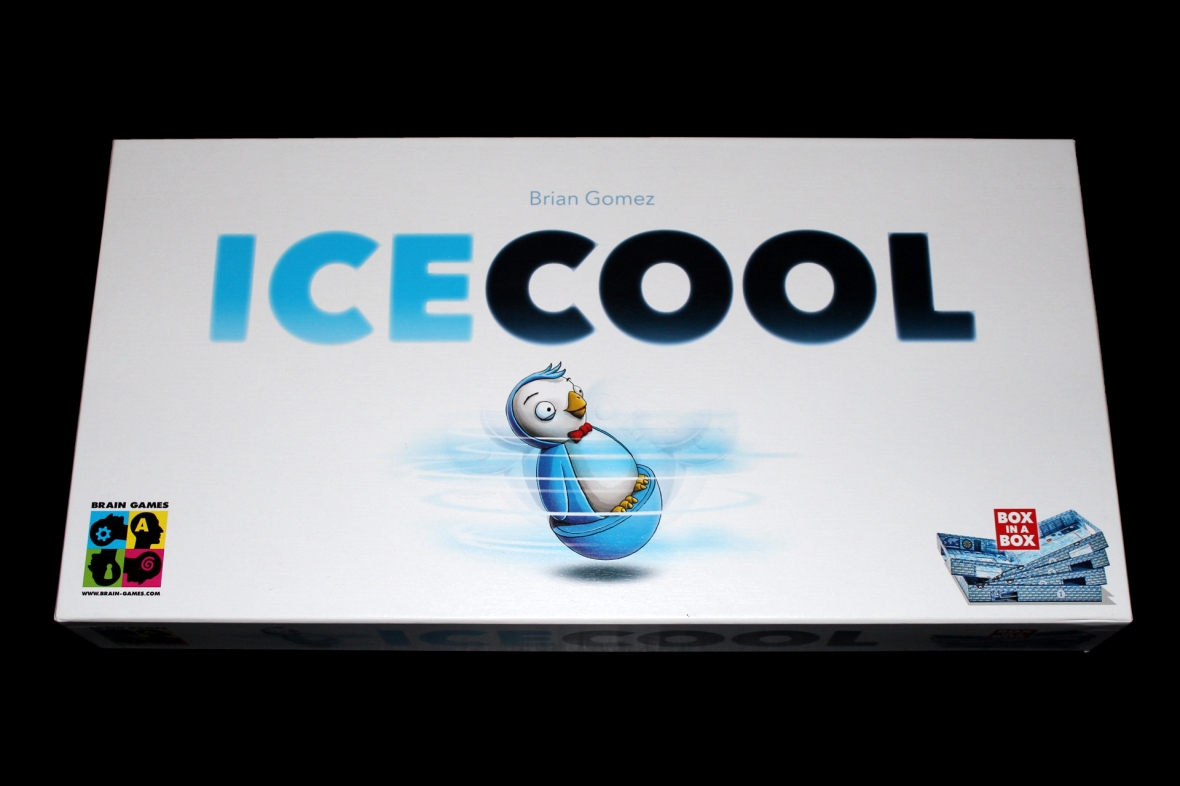
Base price: $40.
2-4 players.
Play time: ~20 minutes.
BGG Link
Buy on Amazon (via What’s Eric Playing?)
So, uh, I’m going to try and review a dexterity game, and you’re going to have to work with me. I might try my best to either post videos of actions being taken where I can’t use pictures, or I’m just gonna try and wing it, but I’m going to do something.
It’ll be great.
Ice Cool, then. To immerse yourself fully in this world, you’re a penguin currently attending a high school (get it?) where you figure you might as well sneak out of class to try and get some fish (ostensibly to eat, I suppose). Unbeknownst to you, your truancy has drawn the ire of the hall monitor, who is going to try and chase you down to take your ID and get you in trouble. Will you be able to slide away from the hall monitor?
Contents
Setup
So, the game is actually super interesting because the game box is part of the game as well:
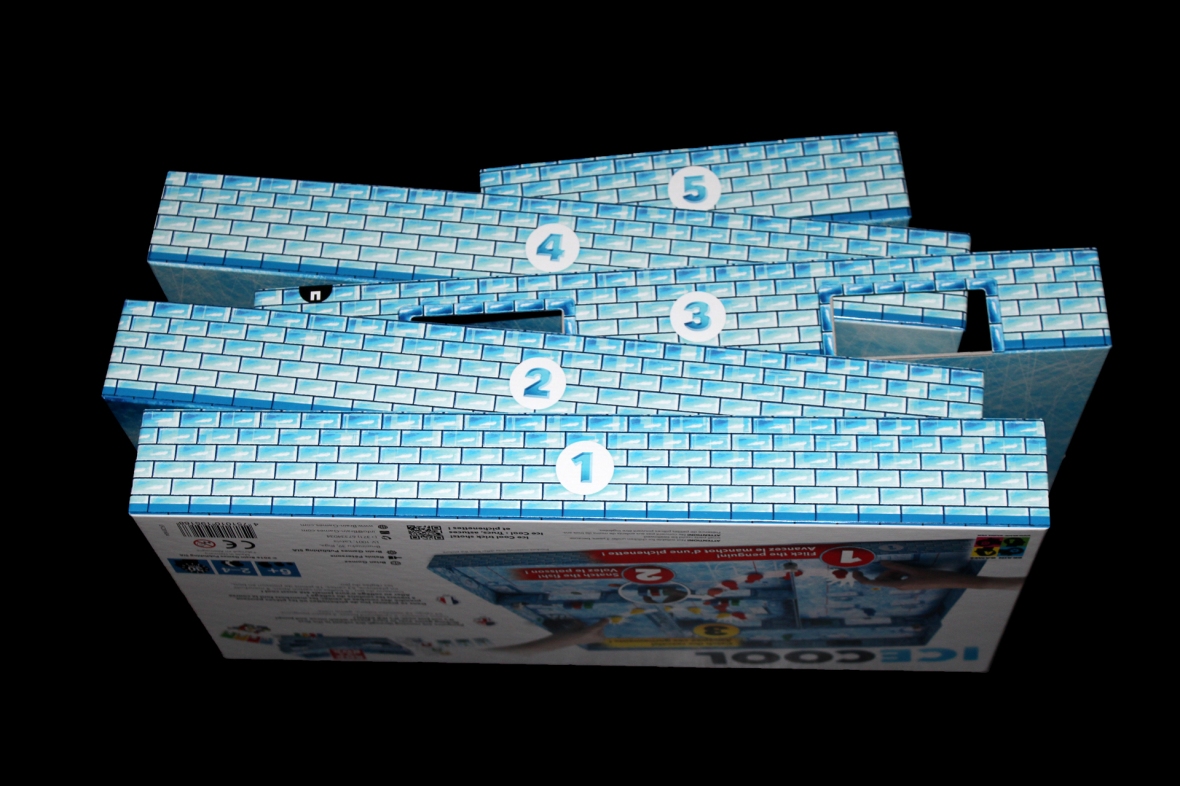
So set those out and find the beigey fish clips:

Put the boxes together by clipping the beigey fish clips on spots that look like this:
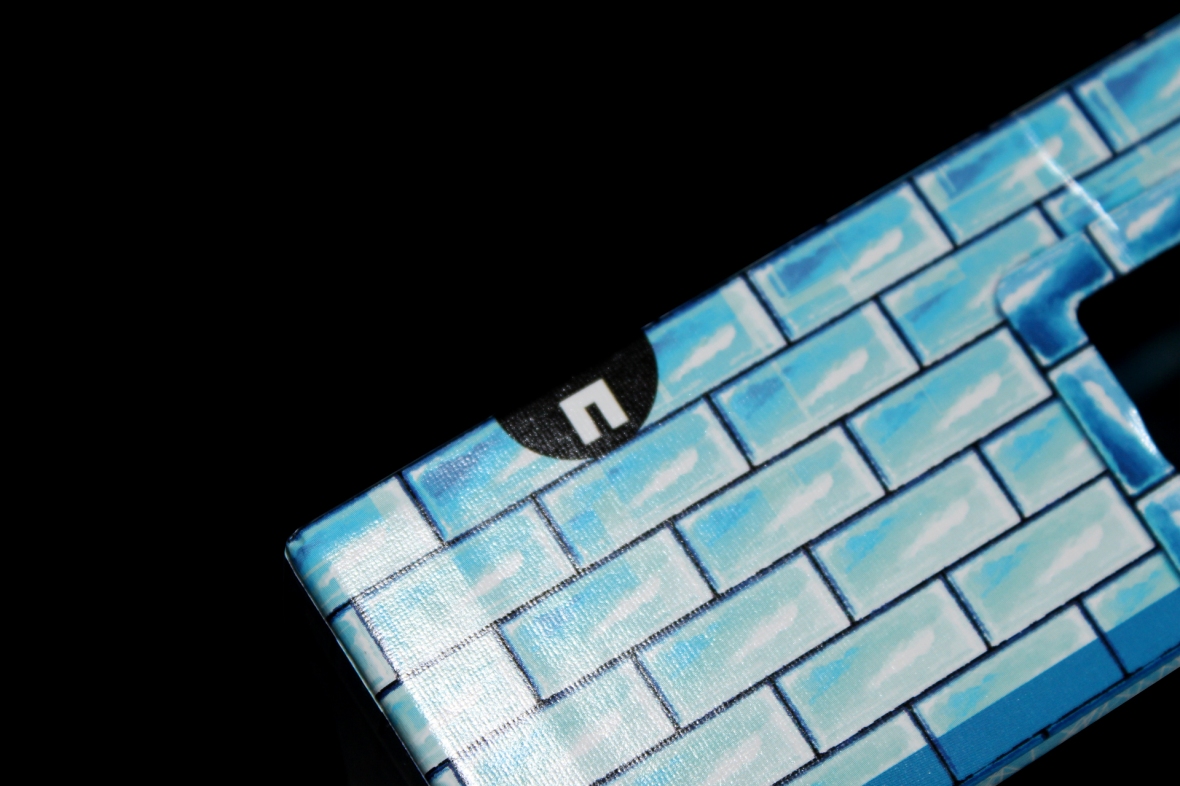
Giving you the completed school. Cool! That was a lot of pictures without much text. You’ll notice that you have three things for each penguin: a picture card, an ID card, and a token. Take those out, and they look like this:
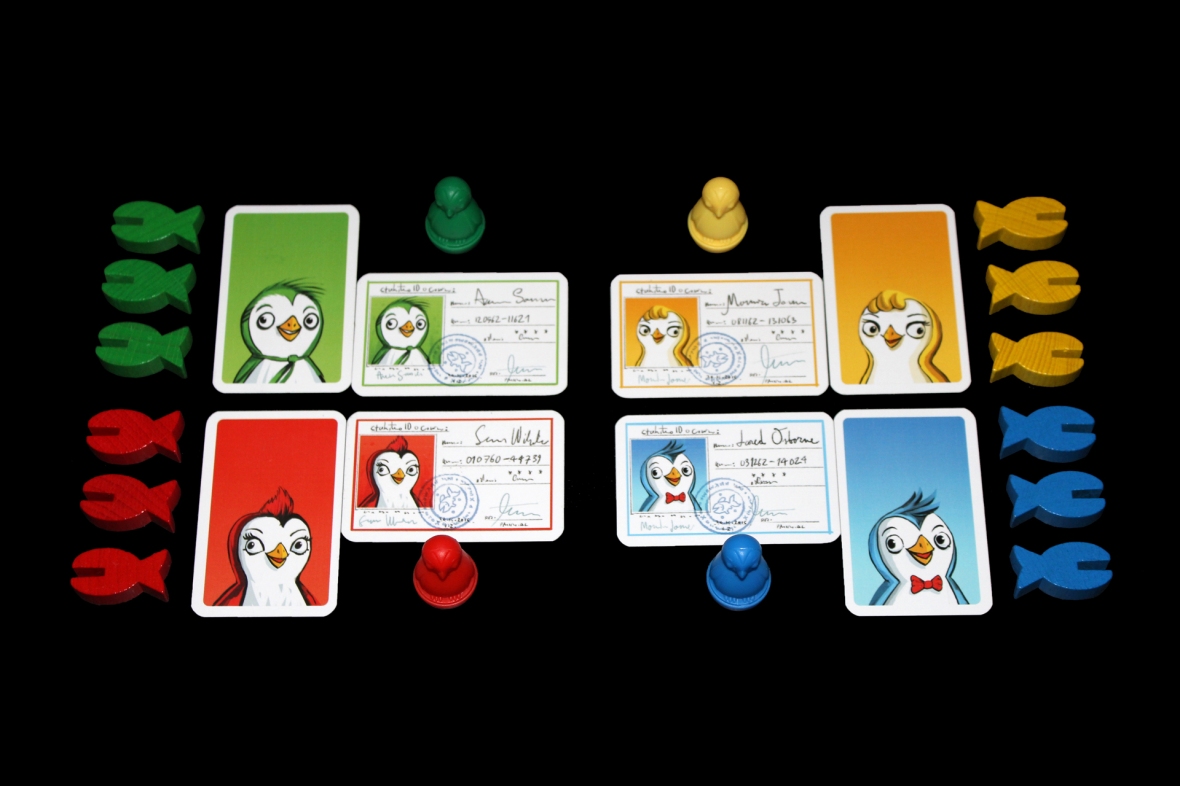
Yeah, this was not an easy photo to edit.
Note that, to my great delight, the ID cards are double-sided, so choose whichever of the two penguins you feel best expresses your identity and preferences. Me personally, I’m the blue penguin with the bow tie. Classy, yet fun. You’ll also notice some fish cards:
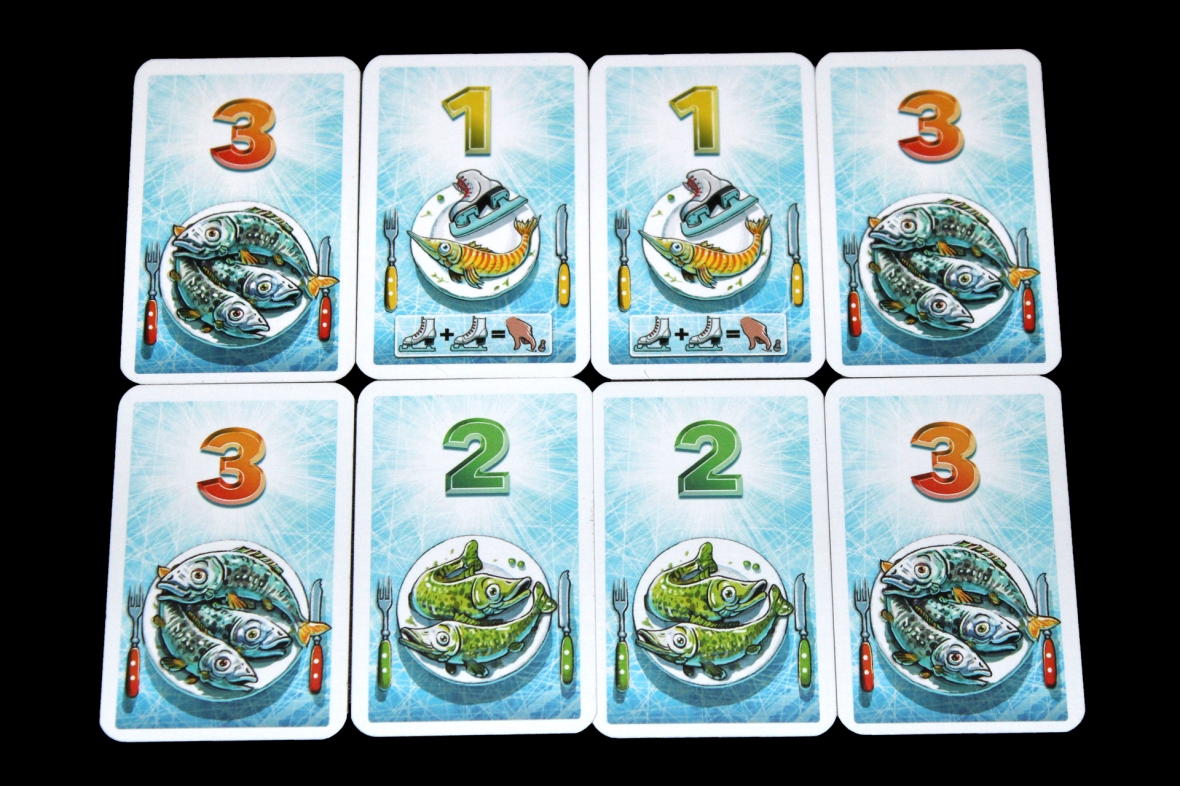
Shuffle those up and set them in a pile. Choose a player to be the first “catcher” (I’ll call it the Hall Monitor, but I think the rules call it something else) and have the player immediately to their left place their penguin on the yellow circle. Also, have every penguin except for the Hall Monitor place the fish tokens of their color on the three fish spaces between doorways on the board. If you’re all ready to start, your area should look like this:
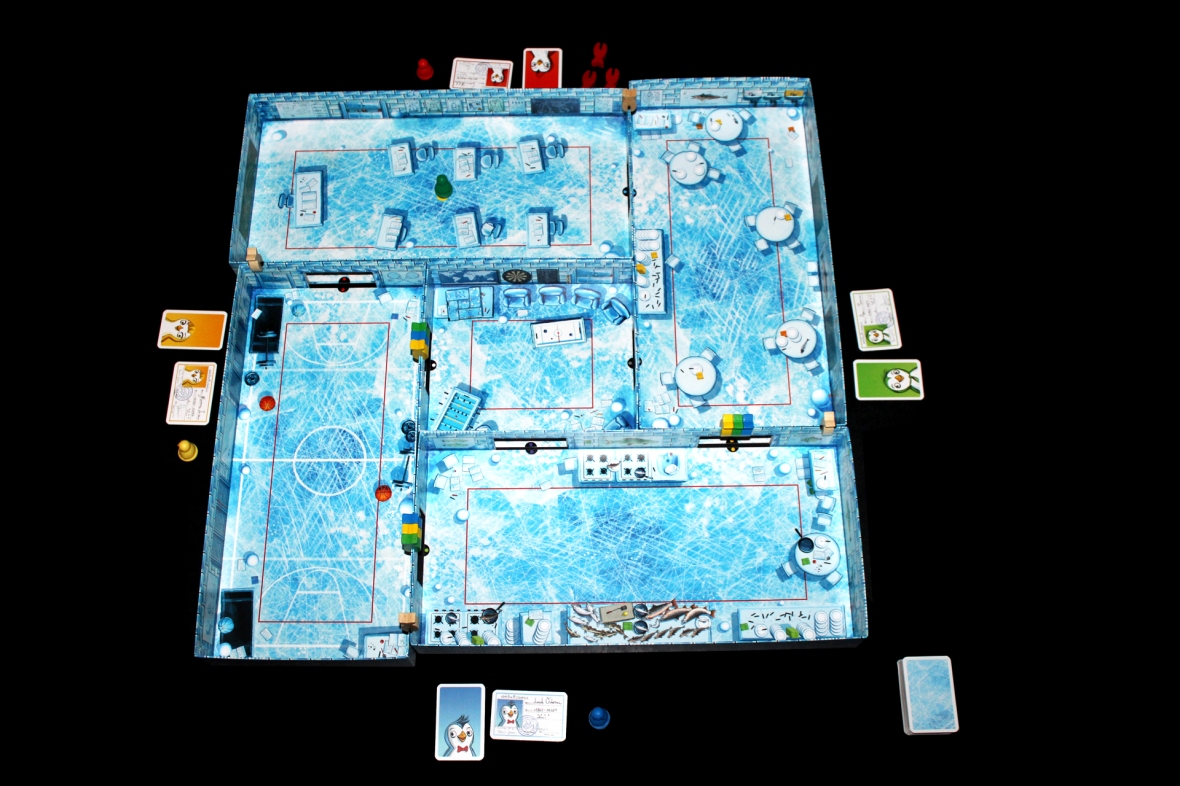
Gameplay
So this is going to be a bit difficult to explain. Basically, there are two different roles. The Hall Monitor wants to slide into the other penguins so that they can acquire the other penguins’ ID cards. The other penguins want to accumulate fish tokens by sliding through doorways that have their fish tokens above them. But how do you do that?
Well, on your turn, you get exactly one move. You can use that move to sort-of-slap-or-push your penguin:
You can use that move to flick your penguin:
Or, if you’re doing a particularly impressive job, you can use that move to jump your penguin, trying to launch them over a wall:
Please note that if you land out of bounds, you go back to the point you jumped the penguin from. This might put you at high risk! If you ever completely slide through a door with your fish token above it, you can remove that fish token and immediately draw a fish card. Note that if you jump over the door, you do not get your fish card. Slide through, not over. Now, while you normally keep those fish cards private, there’s one circumstance in which you don’t want to do so:
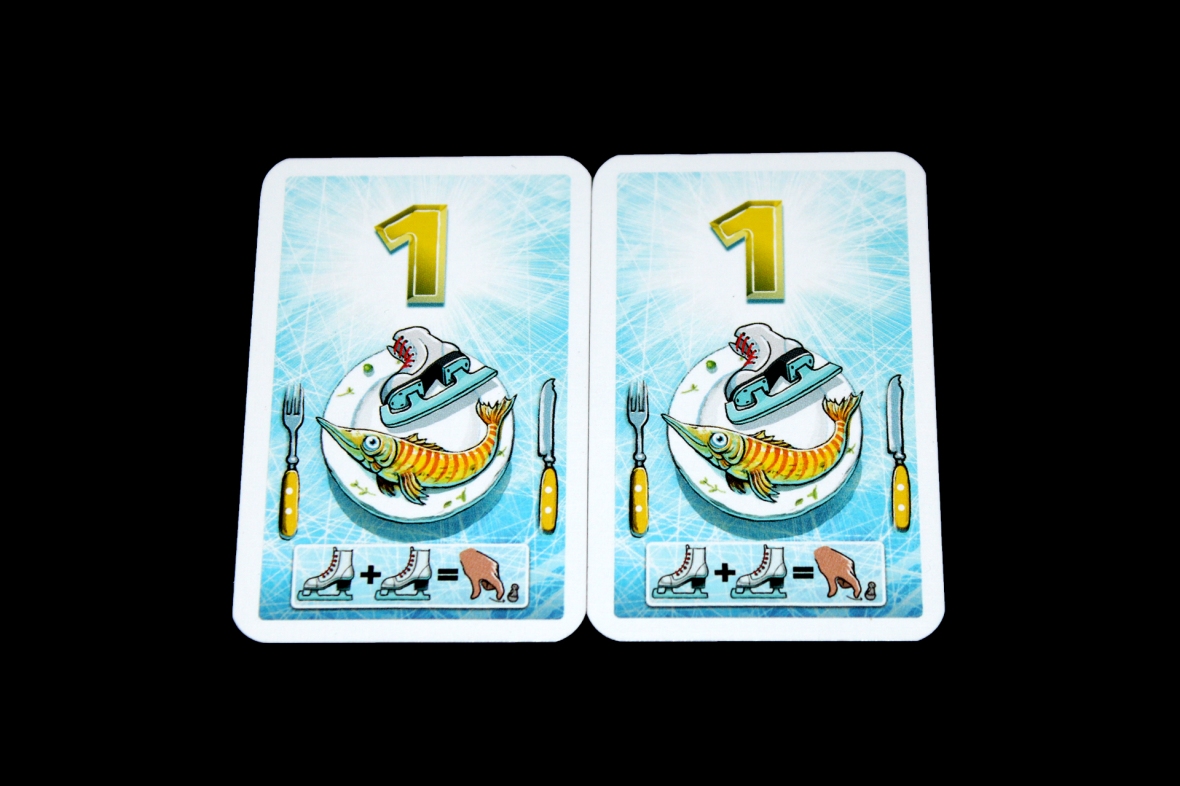
If you have two 1 cards, you can reveal them both and immediately take another turn at the end of your first one. If you happen to have another set of two 1 cards, you can take another turn at the end of that one, and so forth. There’s no limit! Once the cards are used, they stay in your score pile, they’re just visible to all players at that point. Really, it’s just to make sure you don’t re-use them, I think. Play continues until a player has collected all of their fish tokens. Though there’s another way the round can end.
While you’re trying to slide through the doors and catch fish, the Hall Monitor is trying to catch you. If they ever hit you (or you hit them) (or you’re hit into them by another player), they immediately take your ID card. Sad! You’ll probably get some detention for that. But that’s not all! If the Hall Monitor collects every player’s ID cards, the round immediately ends as well. So basically, either a player collecting all the fish ends the round, or the Hall Monitor collecting all the IDs.
At the end of a round, starting with the Hall Monitor, each player takes an additional fish card for every ID card that they still have. Note that the Hall Monitor always has their own ID, so they’ll always take at least one, but a successful Runner might actually get fish cards during the round and an additional fish card for avoiding the Hall Monitor! What a bonus. Once you’ve ended the round, the next player clockwise from the current Hall Monitor becomes the Hall Monitor and a new round starts! Gameplay continues until all players have had a turn as Hall Monitor, and then the game’s over. Count up your fish cards; the player with the most points wins!
That said, there are a few caveats to gameplay:
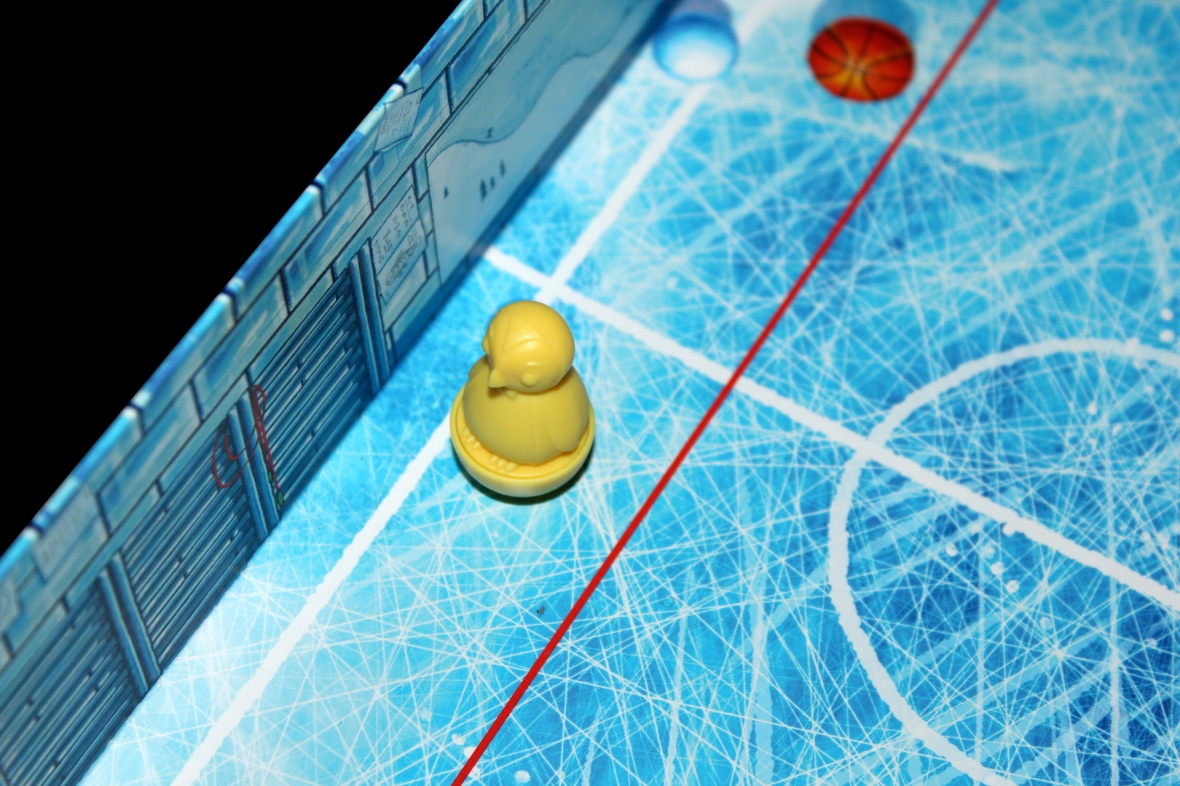
Check out that red line. See how the penguin is between it and the wall? Well, when that happens, you must move your penguin to the red line at the start of your next turn. It’s both to make it easier to flick and a tiny bit harder to get through doorways, I imagine. Or at least to make some angles more difficult.
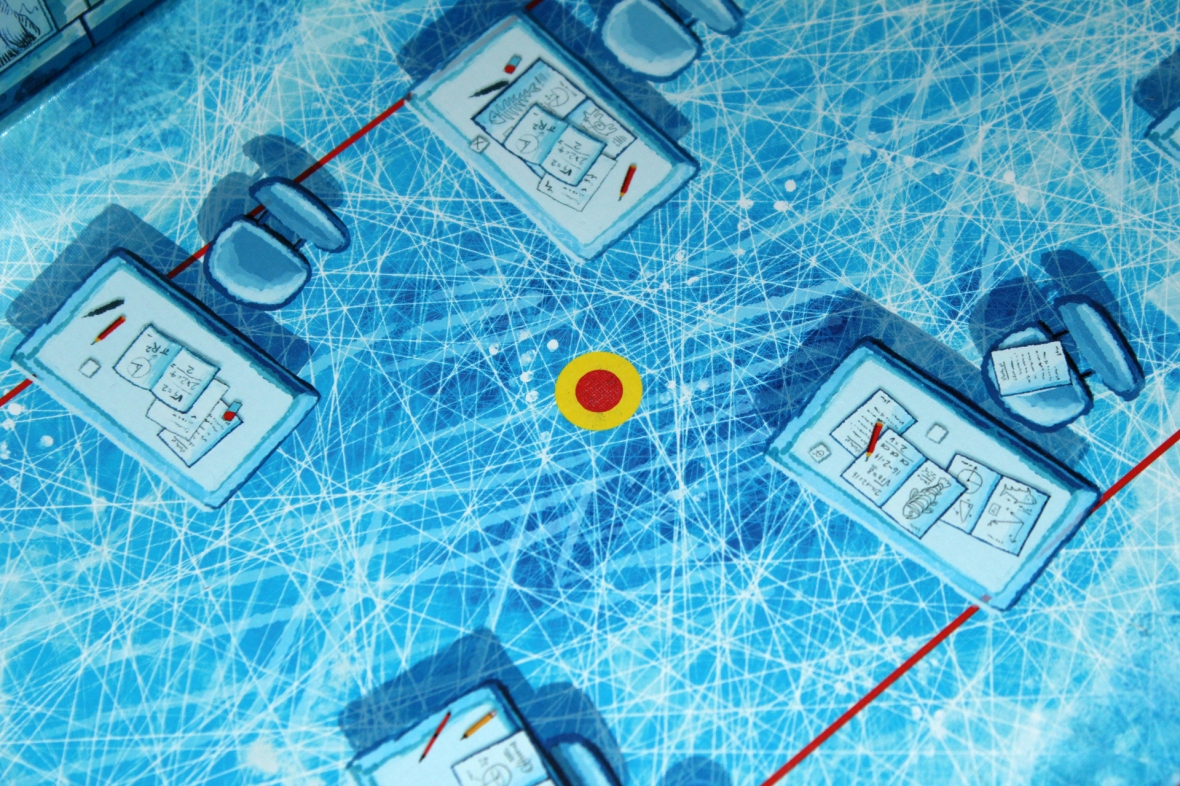
See this yellow circle? This is where you start. You cannot finish your turn on the yellow circle, so even if you happen to jump out of the school, you’ll get another flick for free. Maybe don’t spend the entire game jumping out of the school, as that will irritate your co-players, but it might be worth going big on your first turn? Who knows.
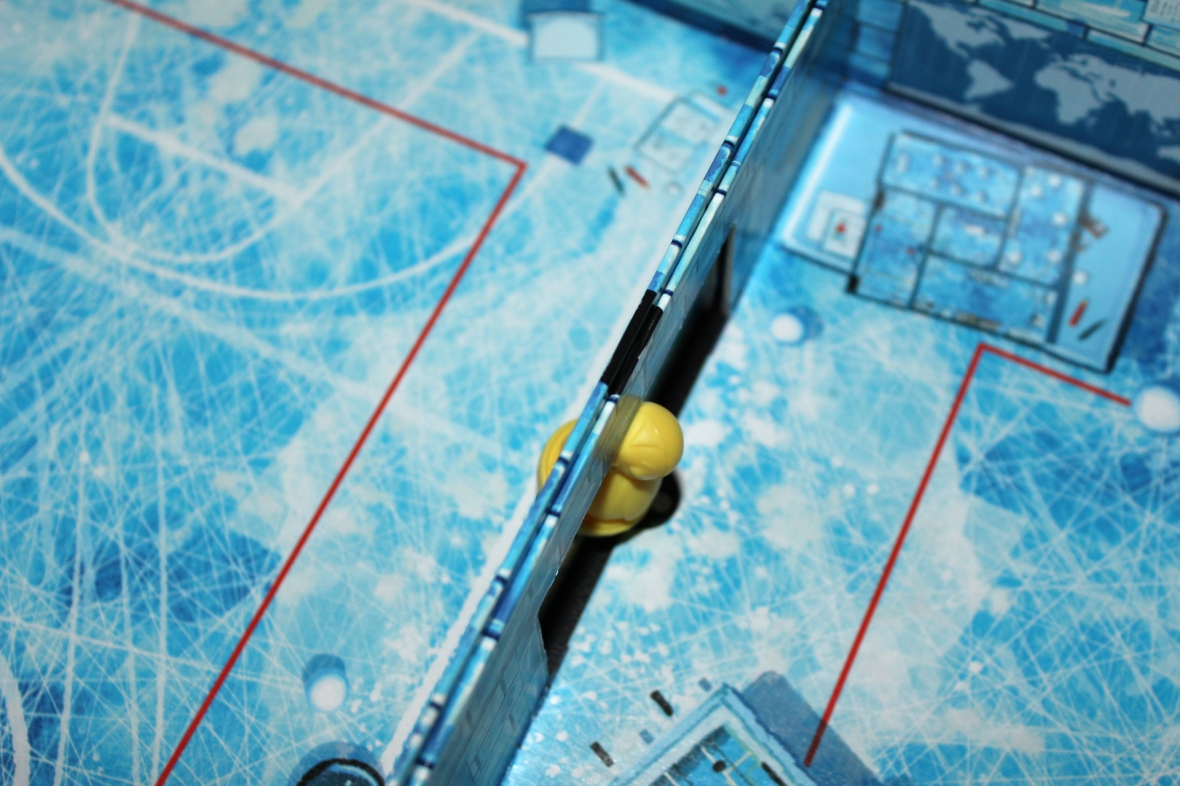
This will happen a lot to you — your penguin gets stuck in the door. If you just got stuck in the door, too bad! You didn’t completely make it through, so no fish for you. If you went completely through the door and happened to backspin your way back into it, well, you made it through, so take a fish! That said, you can place your penguin on either red line, provided there’s a bit of your penguin in both rooms. If your penguin is completely in one room or the other, place them on that red line, as you’d assume.
Player Count Differences
So the major difference is that with two players, you actually play four complete rounds of Ice Cool, in which each player gets to be the Hall Monitor twice. There’s also some interesting change to gameplay to try and make the rounds a bit longer:
- If the Hall Monitor hits you, lose your ID and go back to the starting location. You have to be hit twice for the round to end.
- On the turn the Hall Monitor hits you, they cannot use two 1 cards to take another turn. Otherwise they might be able to instantly hit you again and end the round, and they’re trying to prevent player frustration, not exacerbate it.
Other than that, there’s no real difference. In three- and four-player games you have some personal benefit that the Hall Monitor might not go after you specifically, but there’s also a bit more entropy because you have to deal with other people ending up in your way or blocking things that you need to go through, which can be frustrating.
Strategy
It’s hard to write a strategy article for a dexterity game, because most of it is “slap the penguin and hope for the best” (which, out of context, is probably also a good title for my memoirs). That said, there are a few things that you can keep in mind to potentially make your plays go a bit better for you:
- Don’t have all the Runners go in the same direction on the first turn. You gotta make the Hall Monitor work for your IDs, so why have everyone go one way? Split up and make sure you never have too many people in the same place at the same time.
- If you get your ID stolen, you don’t lose anything from hitting the Hall Monitor. Remember that. This slightly incentivizes you to prevent the Hall Monitor from hitting other players and ending the round, but not by much (since the other players get a benefit by not being hit). What you choose to do is up to you, but if the Hall Monitor hits everyone, you lose the opportunity to score that round.
- Unless you’ve got it down, jumping is a bit of a risky technique. I have not seen many players who really get the penguin to do what they want when they jump, so I wouldn’t necessarily recommend doing that unless you’ve gotten some practice. If you overcommit, you’ll just end up out of bounds and back where you started, which is never good.
- Double 1 cards (Ice Skates) are super useful as both a Hall Monitor and a Runner. It’s not a bad idea to save your 1 cards for your turn as Hall Monitor and try to do a superturn and take everyone’s ID cards in one fell swoop, if you have the cards for it. Otherwise, I’d just use it to make up for a flubbed shot or to try to get the last fish token and end the round.
- Practice. You can get better at your aim and your shots if you’ve played a bit, so maybe practice up if you want to get good? This is definitely a game you can become better at.
- Don’t help other players. You get nothing from helping them unless you’re sure that, say, Player 2 has more fish cards than Player 3, the Hall Monitor, so you accidentally bump P2 into P3. Whoops! In the same vein, try not to push other players through doorways or anything like that if you can avoid it.
As for specific flick techniques and such, you’re on your own.
Pros, Mehs, and Cons
Pros
- I love this theme. I don’t think there’s a theme in a game that I love more. Penguins are one of my favorite animals, it’s a fun concept, and it’s a super fun game to play.
- I also love the art. The art is fun and whimsical and feels playful, and it really suits the game. I’d say both the art and theme are just, triumphs.
- Short and easy to learn. This is a game you can teach pretty much anyone and they’ll be able to pick it up. I end up bringing it to parties to teach sometimes for that and another reason:
- It looks super cool. This is not what people think of when they think of a board game, and it’s gotten a lot of my friends into tabletop gaming or made them reconsider what their notions of gaming are. It’s very different, it’s off-the-wall, and I’d love to see more places experiment with “weird” game formats and styles like this.
- Hell, it’s a ton of fun. I’ve laughed until I cried with this game, I’ve applauded amazingly impressive trick shots, and I’ve cheered with a clutch last-minute hit to steal an ID from another player. It’s just a really, really fun, well-designed game. Probably a great gift for the holidays.
- The penguin tokens are awesome. They’re wobbly and slidey and just all-around a neat little token for a game. Huge fan.
Mehs
- Definitely has a learning curve. Playing with an experienced player can be frustrating if they’re just zipping circles around you and you can’t get your penguin out of the first room. Be gentle with new players and potentially let them take mulligans or practice shots before committing to something. It’s hard, at times, especially to make some of the shots you might need to win.
Cons
- I’m not enamored with the scoring system. I think it’s better than Saboteur but still runs into some of its issues, in that you can just randomly draw crappy cards. Let’s say you do three times better than another player and every round you unluckily get three 1s. If that player draws a 3 every time and you have a bad round, even though you got more fish you’ll still lose. That can be irritating, especially if you have some bad rounds to start and you don’t feel like you can catch up. I think the Ice Skates are designed to help with a catch-up mechanic of some kind, but that only helps if you already have cards. If you’re struggling just to get them, well, you’re going to get left behind. And that might not be fun.
Overall: 9 / 10
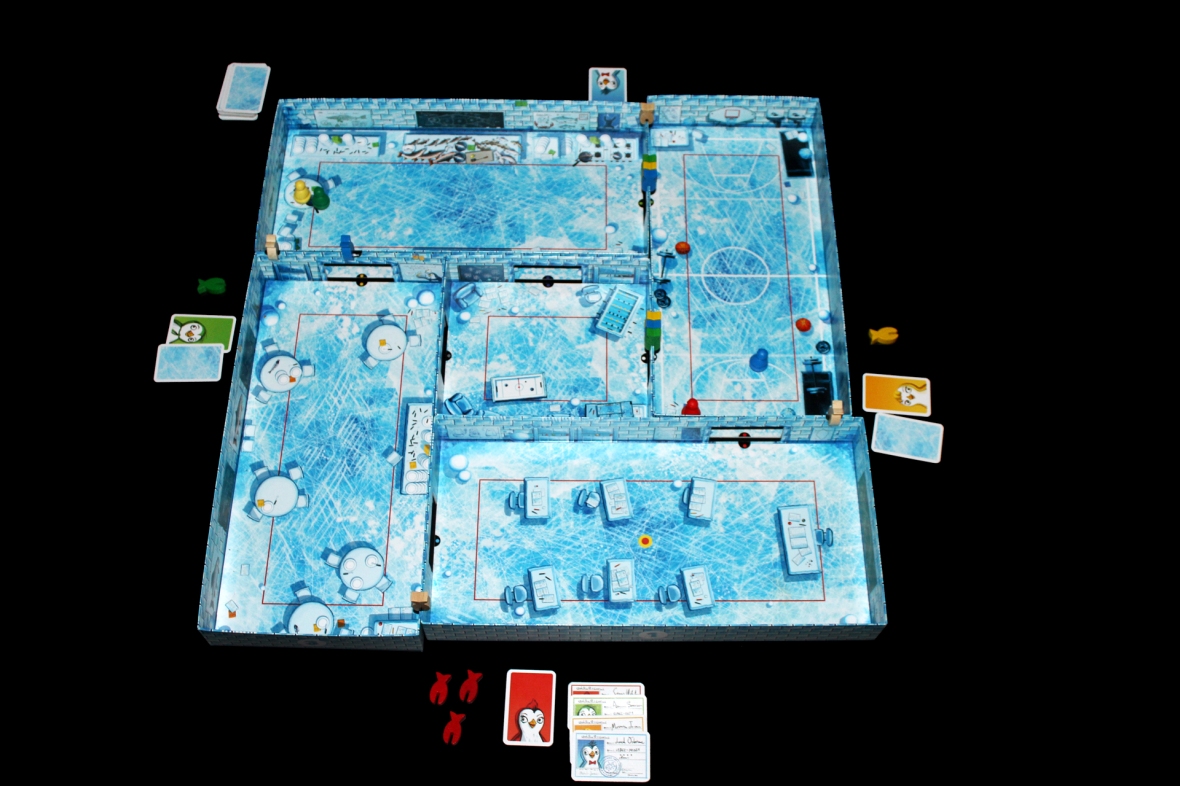
Overall, I’d go so far as to say that Ice Cool is one of my current favorite games (and hopefully that’ll be true for a while). I loved it when I got the chance to play it at Gen Con, I basically bothered people until it released to try and buy it (and bought it the first chance I got), and I’ve been playing it pretty much weekly-or-so ever since. I think it’s a great game for all ages (except anyone who would try to eat the penguin pieces, so, at your own risk, I guess?) and, most importantly, something new and refreshing. I wouldn’t come up with a game like Ice Cool if I were designing a game, and I think that’s an amazing thing about it. It’s progressive for the hobby without taking itself too seriously (I mean, after all, it is a dexterity game) and it’s a game I think everyone in the hobby should at least try (though I’d definitely recommend it for any collection).
Plus, it’s got penguins. It’s just, awesome.